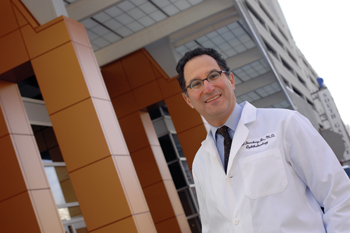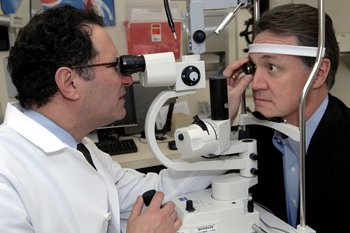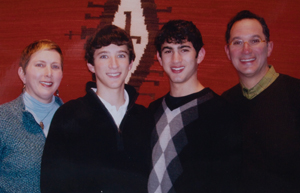
Paul Sternberg Jr., M.D., outside the new Vanderbilt Eye Institute, which is set to open early next month. (photo by Dana Johnson)
VUMC Reporter profile: Eye Institute’s Sternberg keeps focus on the future

A strong clinical program is crucial to Sternberg, here examining patient David Perdue in the Ophthalmology clinic. (photo by Dana Johnson)

From left, Gloria, Zach, Matt and Paul Sternberg
As Paul Sternberg Jr., M.D., strolls through the 50,000-square-foot building that will soon house the Vanderbilt Eye Institute, he examines everything thoroughly.
He can't help it — it's who he is.
Focused.
He likens the daily walk-through to building a home, and his involvement can be seen and felt in every part of the new facility, from the high-tech optical equipment to the tile and upholstery.
It was all in the plan. Long before Sternberg ever came to Vanderbilt as chair of Ophthalmology and Visual Sciences, his destination was certain. The route was the unknown.
Planning ahead
For as long as Dorie Sternberg can remember, her son wanted to be a doctor. Like his father, he chose ophthalmology.
“He is so sincere and a very hard worker,” his mother said. “When he sets out to do something, he does it.”
She still recalls how pleased her husband was when their son chose the research and academic path rather than private practice.
“My husband was a private practitioner and loved it,” she said. “But he always wanted to experience the other side. I have always assumed that Paul was inspired by his father, but he didn't talk much about it. It just seemed to come naturally.”
Sternberg said his father's passion for his work was inspirational. In 2005, one year after his father died, he named a lectureship in his memory — the Paul Sternberg Sr. M.D., Lectureship in Ophthalmology at Vanderbilt.
“My father clearly loved what he did,” he said. “The fact that he just adored his profession and really felt that he was helping people and was fulfilled was motivating. But what I remember the most is when I'd be with him and we'd run into his friends, who were physicians in other fields. They frequently would say: 'Your father got it right. If I had it to do over again, I'd go into ophthalmology. That really stuck with me.''
His commitment to the profession could not be more evident. It is what brought him to Vanderbilt in 2003.
Interestingly, the Ophthalmology chair was open at the same time at Johns Hopkins University, where Sternberg completed his residency.
“Although it was exciting to consider returning to my alma mater, I foresaw that it would be personally more gratifying to grow a department and build one structured around my vision, rather than inherit a large one and retool it,” he said. “That decision largely has to do with my love for challenges.”
There are a number reasons Sternberg and his wife, Gloria, chose to come to Vanderbilt — the leadership of the institution, the role ophthalmology plays in the institution's future, teamwork and the lure of the city itself.
“It was clear from my first conversation with (the leadership) that there was a shared vision of creating a medical center committed to excellence and growth. Also, it was obvious that Ophthalmology was recognized and valued as a jewel in the crown of the institution,” Sternberg said, adding that, nationally, ophthalmology is not a “revenue producer,” yet is a highly successful enterprise.
The Sternbergs were also attracted by the “true collegiality of the Vanderbilt community. It was brought up in every interview I had,” Sternberg said.
“I began to think 'did everyone drink the Kool-Aid or is this real?' I found out quickly that it was even more of a reality than I anticipated. Finally we were attracted to Nashville's friendliness and beauty. We were also impressed with the quality of the schools and the richness of the people we met.
“Our move to Nashville was a shared decision. The whole family bought into the excitement about what we could create at Vanderbilt.”
Eye Institute
Within a few weeks, the Vanderbilt Eye Institute will open for business.
The state-of-the-art, comprehensive eye program is Sternberg's vision. The expansion not only allows for an improved patient experience, but will help with the continuation of building a dynamic research component.
There are a number of well-known eye institutes with national and international acclaim and many have strong research, educational and clinical programs. But Sternberg wanted to forge an innovative program, one that was built on true collaboration across all three areas.
“I want all three traditional areas to work together,” Sternberg said. “My effort here is to try to create a department where scientists, clinicians and educators have a well understood and shared mission. There is a strategic plan that is very clear.”
A world-renowned retina specialist, Sternberg has an active research program focusing on finding biomarkers for age-related macular degeneration (AMD) for personalized, preventive therapeutic treatments. His research goal: to be able to identify early interventions to slow down and/or limit severity and prevent the development of the disease.
The research enterprise at the Eye Institute has three primary focal points — AMD, diabetic retinopathy and glaucoma. The clearly defined research priorities create a unique environment for the team of researchers working to identify new treatments for the most disabling vision conditions in the nation. AMD gradually destroys sharp, central vision necessary for tasks like reading and driving. Diabetic retinopathy is the most common diabetes-related eye disease and a leading cause of blindness. Vision is gradually destroyed without warning in glaucoma.
The art of life
Sternberg's keen eye for excellence doesn't just apply to ophthalmology. It resonates in every aspect of his life.
One of five children, Sternberg grew up in the Chicago suburb of Glencoe, where his parents reveled in the arts and were founding members of the Museum of Contemporary Art in Chicago in 1967.
Surrounded by art since age 9, it remains a prominent theme in Sternberg's life. An avid collector of contemporary photography, he sits on the board of trust at Cheekwood Botanical Garden & Museum of Art. Prior to moving to Nashville, he served as a trustee at the High Museum of Art in Atlanta.
“I truly have a strong commitment to making art available to the community to provide that wide spectrum of art that enriches your life, provides balance, opportunities for reflection and stimulates parts of your brain that you don't normally use during your day-to-day activities,” he said.
Jack Becker, president and CEO of Cheekwood, applauds Sternberg's ability to help rejuvenate the museum.
“He has a real passion for the visual arts and museums,” said Becker. “It has been wonderful to work with him. He has been a part of the recent success of Cheekwood and has been able to bring new direction and life to the group. When we heard he was coming to town, we sought him out.
“He is just a smart, strategic thinker,” Becker added. “He is generous, kind and a focused person.”
Colleague Eugene de Juan, M.D., the Jean Kelly Stock Distinguished Professor of Ophthalmology at the University of California San Francisco, agreed.
de Juan and Sternberg met in 1980 during a residency program at the Wilmer Eye Institute at Johns Hopkins University. He said his friend has always been an “extremely intelligent, hard working, effective and stylish person.
“Paul is an important individual for ophthalmology because he is one of the few really dedicated to making our profession the highest quality possible. He is a great teacher, a great promoter of young ophthalmologists and a great mentor. And he's been a great friend.”
de Juan said from the moment Sternberg made the decision to stay in the South, his path was clear.
“He would be a chair of ophthalmology and he would be a great one. I think he recognized that in himself and prepared himself to take on that kind of responsibility. He had the vision.”
Longtime friend Andrew Kauss refers to Sternberg as the quintessential Renaissance Man — a person who is well educated, or who excels, in a wide variety of subjects, skill sets or fields. His interests in arts, music, food, sports and all things intellectual give credence to the moniker.
Kauss, an attorney, met Sternberg while living in Atlanta about 15 years ago. A 10-day trip to Israel together sealed their friendship.
“Paul can talk as knowledgably about the law, modern music, classical music, wine, art, sports…any number of topics, as he can about medicine,” Kauss said. “You would think that as highly accomplished as he is in his professional life that it would be all consuming. It isn't. There is nothing that he touches in his life at which he is mediocre, other than golf, and he is working on that,” Kauss joked.
“He is one of those people who, when he is with you, makes you feel like you are the most important thing on his radar screen. And you are.”
Sternberg chuckles at the Renaissance tag.
“I'm not sure I know what a Renaissance Man is — but if it means I have my own sophisticated form of ADD then, OK. I do have a wide variety of interests and I really like to learn about things. And those things that I don't have much knowledge about and have an interest in, I'll learn.”
Partners
That pattern of thinking was an attraction for wife, Gloria. After a blind date in 1986, the pair was engaged six months later and married in 1987.
“I think his curiosity to continue to learn new things and travel and explore the world, as well as showing such compassion toward people, is special,” said Gloria Sternberg. “Prior to our first date, we talked on the phone a lot. When we finally went out, we felt like we really knew each other.”
The pair share a love for art, specifically photography. She also sits on the board of the Frist Center for the Visual Arts.
“He is very committed to his work, his patients and his staff,” his wife said. “He believes you treat people the way you want to be treated. He truly lives by the motto ‘you lead by example.’
“He is a fabulous father and role model for our children,” she added.
Son Matt, 18, is a senior at Phillips Academy in Andover, Mass. In the fall he will attend the University of Pennsylvania with plans to major in biomedical engineering with a minor in studio art. Matt explained that being a skilled artist would assist in his development of prosthetics and/or drug delivery devices, which is his area of interest.
Sternberg finds it interesting that both he and his son chose their career paths about the same age.
“My roommate in high school gave a toast at my wedding,” Sternberg said. “He said that I was the only person he knew in high school who, when you asked what I wanted to be, I said an ophthalmologist at a university, where I could teach, do research and take care of patients. And here I am decades later doing just that.”
Zach, 16, a sophomore at Montgomery Bell Academy, isn't sure what he wants to be when he grows up, but one thing is certain — he has discovered his passion for music, just like his father.
“I played for years — the clarinet and saxophone — but once I got into my residency there was no time to play. When Zach started about five years ago, it reawakened my interest. He recently made the Midstate All Star Jazz Band and boy, was it terrific.
“Hearing those kids play…man, they could wail. It's great to hear kids who love to play jazz. I love most every kind of music, but most of my training was in classical. I even like country. I learned to love it since moving here. It has been another gift of Nashville. The musicians in this town are so talented. It has been fabulous.”
Sternberg said he and Gloria try not to impose anything on their children.
“Rather, we work to expose them to lots of things and hopefully they will discover their own passions.”
“I was most influenced by my father's emotions — his love for the profession — rather than the actual practice,” Sternberg said. “It wasn't what he did, but how he felt about it. As a parent now, I just hope that my sons can find something they are as passionate about as I am in what I do and how I feel at the end of the day. I feel like I did something meaningful.”
Teamwork
But for Sternberg it's not a one-man job.
“Truly our life is about making this (the Eye Institute) work and succeed,” he said. “Gloria is my partner in this. It is very clear, even at events for the institute, that the vision and success is a team effort. It's not just me. It is the both of us.”
Recently his wife e-mailed the architects about the need for fuller and taller plantings in the atrium of the building so that patients did not have a front seat to the ambulance bay of the Monroe Carell Jr. Children's Hospital.
“She just has that depth of knowledge,” Sternberg said. “It's not just about the project, but the implications and sensitivity of creating an environment that will be pleasing to our patients and families. That's important.”
There is no time to rest on his laurels, though. The George W. Hale Professor of Ophthalmology and Visual Sciences has work to do.
“The new Vanderbilt Eye Institute is a wonderful facility, but our future success lies with the outstanding faculty and staff who work inside its walls. I'm almost 55 and I am where I want to be. Vanderbilt has given me tremendous resources and support to make this a very special place, and I want them to get great returns on their investment.”













